
Try reverse engineering your sales to better nurture your leads
Do you remember your first sale? The thrill of having someone effectively say, “What you have is valuable and I want to pay you for it!” It’s exciting and never gets old, right?
So much of what we strive for in business hinges on finding ways to make our products and services as attractive as possible to prospective customers. One of the best ways to do that is to create a lead nurturing strategy that clearly demonstrates the value of your wares while expertly guiding the customer along the path to purchase. But how does one achieve such a feat?
I recommend starting at the end—with the end purchase from an existing customer—and reverse engineering how you achieved the sale from there.
Think about your best customers: What connection did you establish that led to their purchase from you? Without knowing the details of your business, I bet trust was a big part of the equation. They needed to believe your product or service could meet their needs and deliver something of value.
As such, your lead nurturing strategy will need to build trust with your audience. As a small business owner, you’ll need to demonstrate that you can solve problems that are important to them.
How do you uncover what problems your prospects have (or think they have)?
By listening to them, or course! Yes, it’s simple, and yet, so many businesses struggle to hear their audience. Nurturing leads is about finding ways to listen and encourage conversation. You can listen to your customers in all kinds of ways. For instance:
In person—When you’re talking to prospects or customers, listen more than you speak. Don’t assume you know what they need. Ask thoughtful questions that will help you discover whether or not you can help them—or how you can tailor your product or service to meet their specific needs. Take notes and write down exactly what they say, using their words.
On social media—Start conversations with your followers online. Post questions or create polls on juicy topics that are interesting to them. When someone comments on a post of yours, ask them a follow-up question. Find out more. Be curious and genuine in your interactions to better understand their experience. Copy and paste those answers and exchanges into your small business CRM or contact management database.
In writing—Create avenues for leads to respond, including short surveys (tools like Survey Monkey, Google Forms, and Typeform can help you do that) and email campaigns. Ask them to “hit reply” and let you know what’s true for them. Attach a personalized video message inviting them to share what’s challenging them right now. And gather all that feedback just as they communicate it so nothing gets changed in translation and anyone on your team can access this valuable customer insight.
Now that you’ve listened, how do you turn those notes into a lead nurturing strategy?
Look for patterns. Closely examine how people describe things and the exact words they use. Those are the words and phrases your audience can hear and trigger their interest. Those are the topics that will have them click open an email, watch a video, or stop scrolling long enough to read a post. Those are the challenges and issues that are relevant and meaningful to them.
Take steps to address those topics, demonstrating your expertise in your field and your ability to solve the unique challenges your customers are facing.
What’s the best way for you to communicate what you want them to know?
This stage is where you can begin to leverage the latest technologies and trends to cultivate an ongoing conversation with your audience. Consider which method you might use to best answer their questions as well as which method the customer is most receptive toward. It might be a video, downloadable checklist, how-to guide, blog, email series or social media post.
Once you identify which methods will be most effective, seek out the small business tools you’ll need to execute your lead nurturing strategy. It’s important that you have a way to organize your customers, their preferences, and the contact details necessary for you to deliver your message. There are great software options on the market designed specifically for small business lead nurturing that help centralize that data and make it easy for everyone on your team to access this vital information.
Executing your lead nurturing strategy can become a tedious and time-intensive process if you let it. The good news is that with automation of email and social media posts, you can streamline much of that work. Anything you create for your lead nurturing campaign can be re-purposed.
Your leads are likely coming from multiple channels, especially online. Therefore, use what you create to bring new prospects into the conversation by demonstrating your expertise across all your marketing efforts. What’s interesting and engaging to one ideal customer may also resonate with others.
So, start with your best customers, who represent the kind of leads you’d like to attract. Look for the connections and interactions that needed to occur for those sales to happen and reverse engineer a game plan from there for your lead nurturing strategy. Then, think about the best way to communicate your value proposition to the client. One thing’s for sure—there are plenty of people out there with problems they’d love to have you solve!
Business & Finance Articles on Business 2 Community(46)








